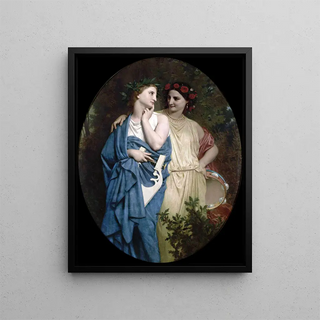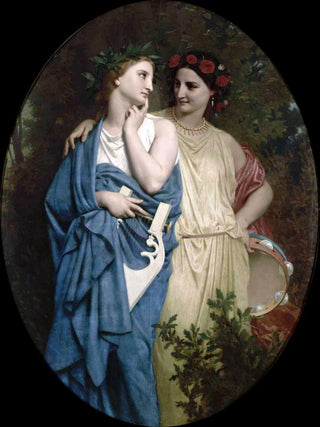Art print | Philomela and Procne - William Bouguereau


View from behind

Frame (optional)
William Bouguereau's "Philomèle et Procné" art print is a true masterpiece that immerses the viewer in a mythological story filled with intense emotions. This painting, created at the end of the 19th century, evokes the tragedy of two sisters, Philomèle and Procné, whose story is marked by revenge and suffering. Bouguereau, a master of realism and emotional expression, manages to capture the essence of this ancient drama with remarkable finesse. Gazing at this work, one is immediately transported to a universe where beauty and pain coexist, a poignant reflection of human passions.
Style and uniqueness of the art print
Bouguereau's style is characterized by technical precision and meticulous attention to detail. In "Philomèle et Procné," the faces of the characters are strikingly expressive, revealing complex emotions. Light plays a crucial role in this composition, delicately illuminating the faces and bodies while creating shadows that enhance the scene's depth. The drapery of the clothing, rendered with unparalleled mastery, adds a tactile dimension to the art print, inviting the viewer to feel the texture and movement. Bouguereau also uses rich, harmonious colors that reinforce the emotional impact of the scene. This blend of realism and romanticism gives "Philomèle et Procné" an atmosphere that is both timeless and poignant.
The artist and his influence
William Bouguereau, born in 1825, is one of the most emblematic artists of the French academic movement. His career, marked by numerous exhibitions and awards, testifies to his exceptional talent and ability to capture human beauty. Bouguereau stands out with his unique approach that combines tradition and innovation. His works, often inspired by mythology and literature, explore universal themes such as love, suffering, and redemption. Bouguereau's influence extends far beyond his era, inspiring many contemporary and future artists to explore human emotions through similar techniques. His ability to

Matte finish

View from behind

Frame (optional)
William Bouguereau's "Philomèle et Procné" art print is a true masterpiece that immerses the viewer in a mythological story filled with intense emotions. This painting, created at the end of the 19th century, evokes the tragedy of two sisters, Philomèle and Procné, whose story is marked by revenge and suffering. Bouguereau, a master of realism and emotional expression, manages to capture the essence of this ancient drama with remarkable finesse. Gazing at this work, one is immediately transported to a universe where beauty and pain coexist, a poignant reflection of human passions.
Style and uniqueness of the art print
Bouguereau's style is characterized by technical precision and meticulous attention to detail. In "Philomèle et Procné," the faces of the characters are strikingly expressive, revealing complex emotions. Light plays a crucial role in this composition, delicately illuminating the faces and bodies while creating shadows that enhance the scene's depth. The drapery of the clothing, rendered with unparalleled mastery, adds a tactile dimension to the art print, inviting the viewer to feel the texture and movement. Bouguereau also uses rich, harmonious colors that reinforce the emotional impact of the scene. This blend of realism and romanticism gives "Philomèle et Procné" an atmosphere that is both timeless and poignant.
The artist and his influence
William Bouguereau, born in 1825, is one of the most emblematic artists of the French academic movement. His career, marked by numerous exhibitions and awards, testifies to his exceptional talent and ability to capture human beauty. Bouguereau stands out with his unique approach that combines tradition and innovation. His works, often inspired by mythology and literature, explore universal themes such as love, suffering, and redemption. Bouguereau's influence extends far beyond his era, inspiring many contemporary and future artists to explore human emotions through similar techniques. His ability to






